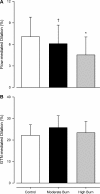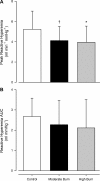Vasodilator function is impaired in burn injury survivors
- PMID: 30256680
- PMCID: PMC6295495
- DOI: 10.1152/ajpregu.00188.2018
Vasodilator function is impaired in burn injury survivors
Abstract
The effect of severe burn injury on vascular health is unknown. We tested the hypothesis that, compared with nonburn control subjects, vasodilator function would be reduced and that pulse-wave velocity (a measure of arterial stiffness) would be increased in individuals with prior burn injuries, the extent of which would be associated with the magnitude of body surface area having sustained a severe burn. Pulse-wave velocity and macrovascular (flow-mediated dilation) and microvascular (reactive hyperemia) dilator functions were assessed in 14 nonburned control subjects and 32 age-matched subjects with well-healed burn injuries. Fifteen subjects with burn injuries covering 17-40% of body surface area were assigned to a moderate burn injury group, and 17 subjects with burn injuries covering >40% of body surface area were assigned to a high burn injury group. Pulse-wave velocity [ P = 0.3 (central) and P = 0.3 (peripheral)] did not differ between the three groups. Macrovascular dilator function was reduced in the moderate ( P = 0.07) and high ( P < 0.05) burn injury groups compared with the control group. Likewise, peak vascular conductance during postocclusive reactive hyperemia differed from the moderate burn injury group ( P = 0.08 vs. control) and the high burn injury group ( P < 0.05 vs. control). These data suggest that vasodilator function is impaired in well-healed burn injury survivors, with the extent of impairment not dependent on the magnitude of body surface area having sustained a severe burn injury.
Keywords: burn injury; flow-mediated dilation; reactive hyperemia.
Figures


References
-
- Aboyans V, McClelland RL, Allison MA, McDermott MM, Blumenthal RS, Macura K, Criqui MH; The Multi-Ethnic Study of Atherosclerosis . Lower extremity peripheral artery disease in the absence of traditional risk factors. Atherosclerosis 214: 169–173, 2011. doi:10.1016/j.atherosclerosis.2010.10.011. - DOI - PMC - PubMed
-
- Anderson TJ, Charbonneau F, Title LM, Buithieu J, Rose MS, Conradson H, Hildebrand K, Fung M, Verma S, Lonn EM. Microvascular function predicts cardiovascular events in primary prevention: long-term results from the Firefighters and Their Endothelium (FATE) study. Circulation 123: 163–169, 2011. doi:10.1161/CIRCULATIONAHA.110.953653. - DOI - PubMed
-
- American Burn Association National Burn Repository. Chicago, IL: American Burn Association, 2014, p. i-35.
Publication types
MeSH terms
Substances
Grants and funding
LinkOut - more resources
Full Text Sources
Other Literature Sources
Medical

